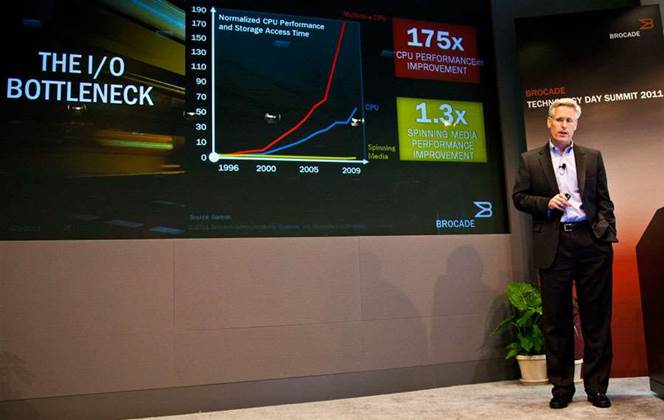Future is bright for fibre channel
Analysts at Technology Day said that fibre channel technology was a safe bet for at least another decade, maybe two.
Surgis Mushell, principal storage research analyst at Gartner admitted he previously didn’t expect the FCoE market to grow, but now predicts Brocade has breathed new life into this area by combining a HBA/CNA/NIC card at a low price.

Mushell said the backwards compatibility of Brocade’s 16 Gbps system will ensure CIOs will not be afraid of including it in their upgrade plans.
“The fact they have the 16 Gbps today and the roadmap continues ... the backward compatibility - the support from 16 to 8 to 4 to 2 – means you can keep that infrastructure and keep building up as demand increases, those are very important,” said Mushell.
Infonetics’ Howard agreed and likened the evolution of fibre channel to that of Ethernet.
“Ethernet was initially a 1 Mbps technology, then they announced 10 Mbps, which allowed people to continue buying 1 Mbps knowing that it had a future," Howard said.
"The same phenomenon occurred when people were buying 10 Mbps Ethernet and 100 Mbps was promised, then 1 Gbps, then 10 Gbps and now its 40 Gbps and 100 Gbps. That same principle works with fibre channel.
“Brocade is already working on the next stage, which is 32 Gbps. That means the life of fibre channel is at least 10 years, maybe 15 years [away],” added Howard.
This timeframe seems reasonable, as long as the competition between Cisco and Brocade continues, according to Gartner’s Mushell.
“There are only two main competitors and they will keep pushing at the edge and continue leap frogging each other so the existence of the two is important for the industry,” he added.
Munir Kotadia travelled to San Jose as a guest of Brocade.






.png&h=140&w=231&c=1&s=0)

.png&h=140&w=231&c=1&s=0)



.png&w=100&c=1&s=0)

 Digital Leadership Day Federal
Digital Leadership Day Federal
 Government Cyber Security Showcase Federal
Government Cyber Security Showcase Federal
 Government Innovation Showcase Federal
Government Innovation Showcase Federal
 Digital NSW 2025 Showcase
Digital NSW 2025 Showcase











_(1).jpg&h=140&w=231&c=1&s=0)



